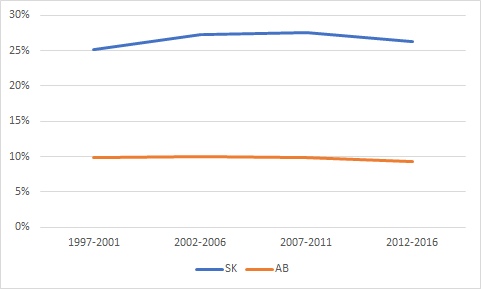Judging by the feedback on yesterday’s blog, y’all are pretty interested in demography (One Thought followers are the best followers. How great is it that my most popular blogs are about demography?). So, I thought I would follow up on the three biggest threads of questions and commentary which have flooded my inbox and blog comments over the last 24 hours.
First: where did I get the data? Well, that one’s easy. Statistics Canada does projections every few years, for every province and for the entire country. The technical term for the data source is Table 17-10-0057-01, or you can just follow this link and play with the data to your heart’s content. There are multiple projections (based on various assumptions, none of which matter a whole lot if you restrict your projections to 2038 as I did, because most of the people being projected here have already been born), and for the record I used projection M4.
Second: how much of that big jump in the Prairie numbers is due to a growth in the size of the Indigenous population and what – if any – does a shifting ethnic demographic make to how population changes translate into enrolment changes?
The answer here is complicated. It is certainly the case that Indigenous birth rates are higher than non-Indigenous birthrates and are projected to remain so through the 2030s. But in the case of both Saskatchewan and Alberta (and Canada generally), this is offset by the fact that the non-Indigenous population is continually being bumped up at all age levels through immigration (obviously, children don’t migrate on their own but immigrant parents do tend to bring their children with them). So, if we look at the 2016 census and break down Indigenous/non-Indigenous by age cohort, we see the Indigenous proportion of the overall AB/SK population of post-secondary education age is going to stay pretty stable over the next couple of decades. As Figure 1 shows, the 1997-2001 birth cohort (which is entering PSE right about now) is 25% Indigenous in Saskatchewan and 10% in Alberta; the 2012-2016 birth cohort (which will be in PSE in the mid 2030s) is almost exactly the same. In other words, yes, Indigenous students are part of the growth story, but they are not an overweighted part of the story.
Figure 1: Proportion of the Population with Aboriginal Identity, Alberta and Saskatchewan, by birth cohort, based on 2016 census

In fact, the bigger part of the story is immigration. Alberta and Saskatchewan are – like many other provinces – expected to attract a lot of foreign immigrants over the next two decades and it is their children who are going to be making up a little over half of the number increases. The rest is going to come from in-province domestic population growth – that is, assuming there is no massive provincial out-migration (which I think is pretty unlikely, no matter how bad the oil patch is going to get).
Third (not so much a question as a line of reasoning): hey, isn’t there an easy solution here? If Prairie universities and colleges are going to be squeezed, Atlantic universities are going to have spaces going begging, couldn’t we do a deal and send the western students to be educated in the east.
Short answer: no. Longer answer: really, no.
Look, we’ve been down this road before. Back in the days of Ontario’s double cohort, when the province was deliberately (and in theory temporarily) doubling the size of the intake cohort, a lot of people out east thought this was a chance to cash in. “Don’t build new capacity” they urged the Ontario government. “Send them our way instead. Give us some money for operating grants and we’ll educate them without you having to add physical capacity and staff. Cheaper all around”. The Harris government – famously averse to public spending – listened to this pitch for about fifteen seconds before wishing the Atlantic emissaries a safe trip home.
The reason is pretty simple. Sending students 3,000 miles across the country to study isn’t cheap. Even assuming the Alberta government might provide operating funding to, say, the University of New Brunswick, who’s picking up the $15,000 a year or so it will take for a kid from Edmonton to live in Fredericton and get back home a couple of times a year? The families? Good luck selling that one. No Albertan who has paid their taxes for a few decades is going to accept the provincial government saying, “thanks for all your tax dollars, oh and by the way we hear the Oromocto river is lovely this time of year”. Governments tend to avoid self-harming in this way.
And it wouldn’t even necessarily be a good deal for the Atlantic institutions, all of whom in practice get from their governments’ lump-sum funding untied to actual enrolments. When they accept new students, their marginal revenue is tuition and nothing more. So now, if you offer an Atlantic institution a choice between a student from Grande Prairie and one from Guangzhou, there is simply no competition, because the latter pays about three times as much. You would have to offer Atlantic universities a lot of public money just to make an out-of-province domestic student as financially enticing as an international student. And as those provinces’ demographics get worse and institutions are required increasingly to rely on their own resources, those kinds of choices are going to get ever-starker.
Unattractive to students and their families, unattractive to institutions: it’s really hard, in short, to see what this option has to recommend it, other than a bit of fantasy about Canadians helping each other out.

 Tweet this post
Tweet this post

Thanks for the detailed answer on Indigenous demographics, Alex!